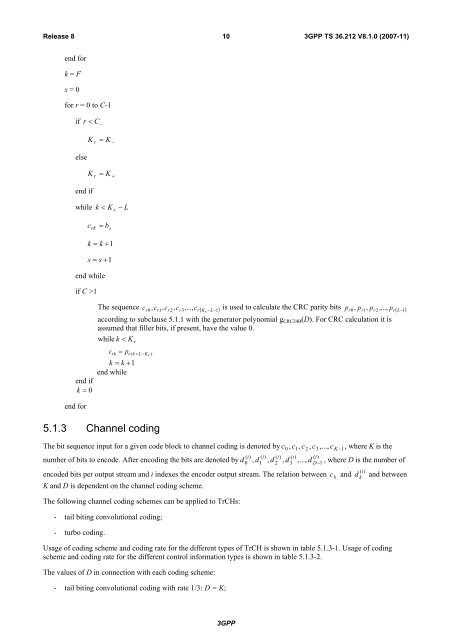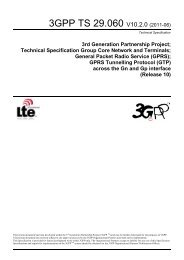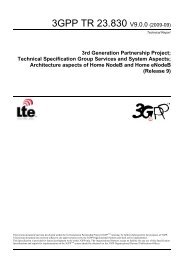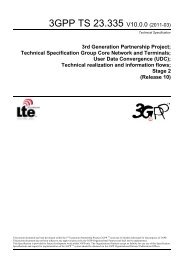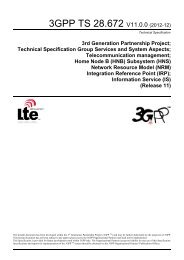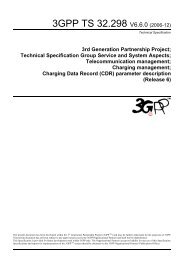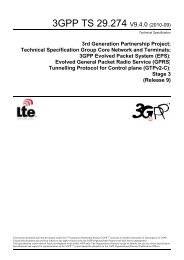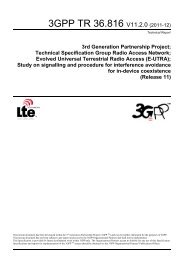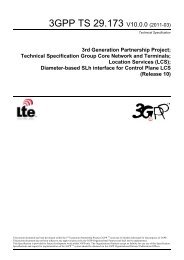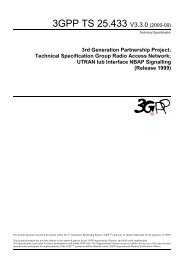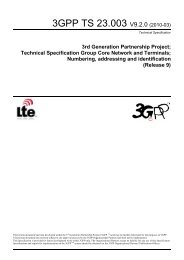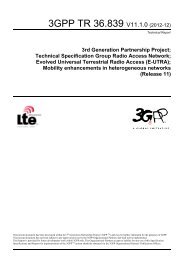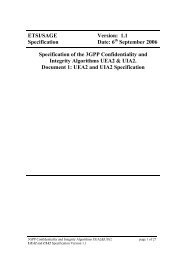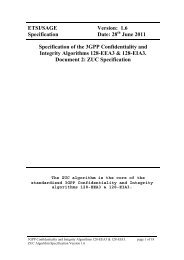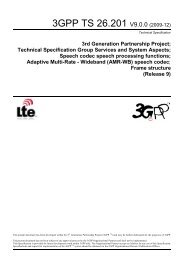3GPP TS 36.212, "Multiplexing and channel coding"
3GPP TS 36.212, "Multiplexing and channel coding"
3GPP TS 36.212, "Multiplexing and channel coding"
You also want an ePaper? Increase the reach of your titles
YUMPU automatically turns print PDFs into web optimized ePapers that Google loves.
Release 8<br />
10<br />
<strong>3GPP</strong> <strong>TS</strong> <strong>36.212</strong> V8.1.0 (2007-11)<br />
end for<br />
k = F<br />
s = 0<br />
for r = 0 to C-1<br />
if<br />
r < C−<br />
K r<br />
= K −<br />
else<br />
K r<br />
= K +<br />
end if<br />
while<br />
k < K<br />
r −<br />
L<br />
c rk = b s<br />
k = k +1<br />
s = s +1<br />
end while<br />
if C >1<br />
end if<br />
k = 0<br />
end for<br />
The sequence c r0 , cr1,<br />
cr2,<br />
cr3,...,<br />
cr( Kr<br />
−L−1)<br />
is used to calculate the CRC parity bits p r0 , pr1,<br />
pr2,...,<br />
pr( L−1)<br />
according to subclause 5.1.1 with the generator polynomial g CRC24B (D). For CRC calculation it is<br />
assumed that filler bits, if present, have the value 0.<br />
while k < K r<br />
crk = p r ( k + L−Kr<br />
)<br />
k = k +1<br />
end while<br />
5.1.3 Channel coding<br />
The bit sequence input for a given code block to <strong>channel</strong> coding is denoted by c 0 , c1,<br />
c2<br />
, c3,...,<br />
c K −1<br />
, where K is the<br />
( i)<br />
( i)<br />
( i)<br />
( i)<br />
( i)<br />
number of bits to encode. After encoding the bits are denoted by d<br />
0<br />
, d1<br />
, d<br />
2<br />
, d<br />
3<br />
,..., d<br />
D− 1<br />
, where D is the number of<br />
(i)<br />
encoded bits per output stream <strong>and</strong> i indexes the encoder output stream. The relation between c k <strong>and</strong> d<br />
k<br />
<strong>and</strong> between<br />
K <strong>and</strong> D is dependent on the <strong>channel</strong> coding scheme.<br />
The following <strong>channel</strong> coding schemes can be applied to TrCHs:<br />
- tail biting convolutional coding;<br />
- turbo coding.<br />
Usage of coding scheme <strong>and</strong> coding rate for the different types of TrCH is shown in table 5.1.3-1. Usage of coding<br />
scheme <strong>and</strong> coding rate for the different control information types is shown in table 5.1.3-2.<br />
The values of D in connection with each coding scheme:<br />
- tail biting convolutional coding with rate 1/3: D = K;<br />
<strong>3GPP</strong>


